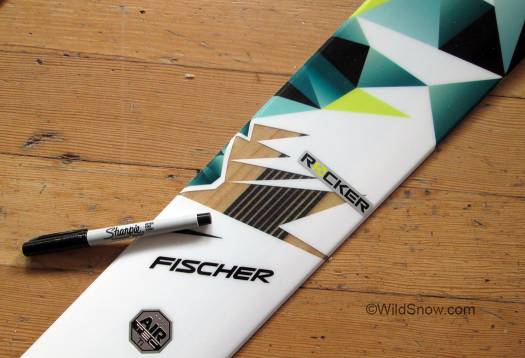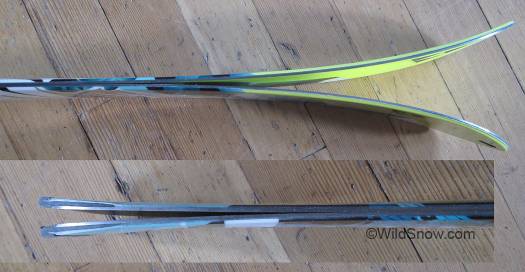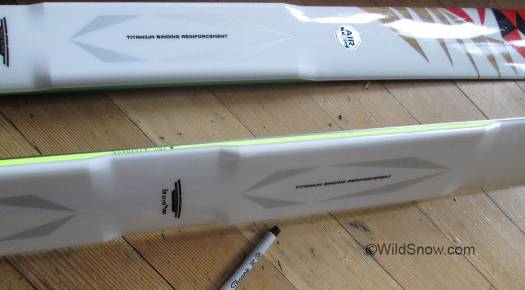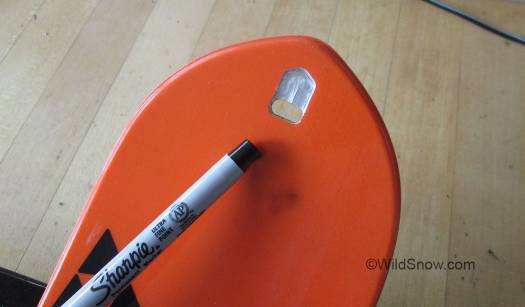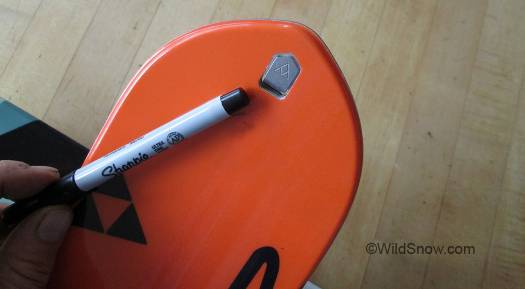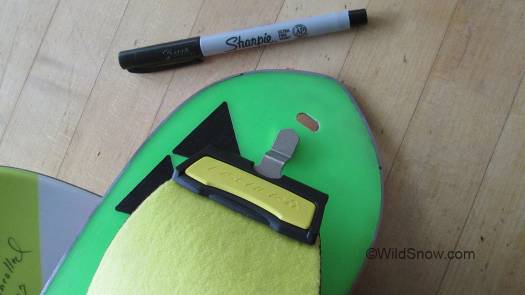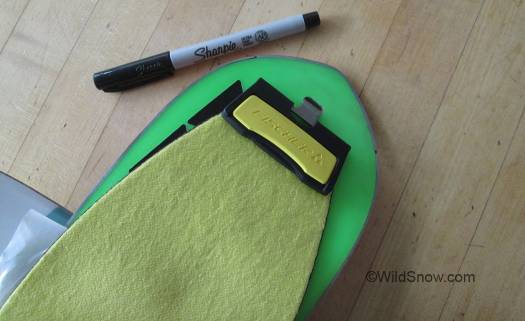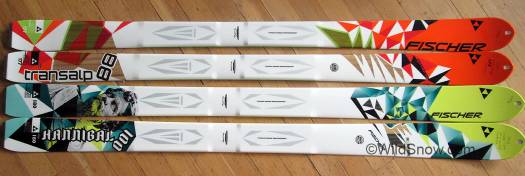
Quite the graphics. Also looks like they ski well. Hannibal at bottom, Transalp 88 at top. Some of the lighter weight skis we’ve had cross our threshold.
That was quite the shindig last winter at ISPO, when Fischer debuted their Transalp touring ski and boot lineup (bindings too, but they were a yawner).
We got this winter’s test samples in just a few days ago. First look:
The first thing you notice with Fischer Transalp skis is the stunning if not overstated graphics. I like the white and light colors of course, along with windows exposing what is ostensibly the core. Lack of sidewalls gives these planks an elegant feel in the hand, and is said to reduce weight by allowing the cross-section to use less material.
These guys do feel light on the biceps test. Reality is Hannibal (131/100/117, 180 cm, 179 cm cord length) masses at 1399 grams, and that is good stuff. Few of the 180 cm skis we’ve evaluated over the years can beat those stats. As to weight vs surface area, as of today Hannibal scores as the 10th lightest we’ve measured of about 60 skis, in the same class as another well known brand’s carbon offering. In other words, these things are feathers with perfect metrics for human powered ski touring. At an MSRP of $699.99? Excellent.
Thus, one has to admit there is something to Fischer’s claim that their no sidewall “Aeroshape” construction reduces weight, as these planks still have full wrap steel edges at the tip, with tail edges terminating in traditional fashion at the tail protector.
Hannibal flex is supple (powder couch!) with moderate rocker at the tip and a dose at the tail. Specifically, the tip rocker terminates at about 38 mm from the tip with ski on flat surface.
My only gripe in this first look? Both Hannibal and 88 are stickered as “Made in Ukraine,” my least favorite country in the world, where so many hack attacks and content scraping attempts originate I ended up blocking the whole country (if you’re from Ukraine and not a hacker, contact me and I’ll whitelist you. Perhaps you work in the factory where the Fischer skis are made?)
Let’s do an about face and talk about the Transalp 88 (yep, 88 mm waist). Using the same Aeroshape cross section, the 88s come in at a weight/surface score of 73 (range at this time is 60 to 108). That’s still on the good side of our chart, excellent in fact, though not quite as efficient a platform as Hannibal. But check out the weight/length, 9th on our list and right in there with other super-light carbon skis, some of which are pricey.
Transalp 88 is of course your more classic European touring ski. No real rocker, just a slow rise tip and perhaps a tiny bit of tail rise compared to trad geometry. A bit more sidecut (radius 19 meters) and moderately stiff. Like I said, classic. I’d take them on an Alps ski traverse any week of the year. Our 177 cm Transalp 88 testers average at 1303 grams, 123/88/111.
Hannibal and Transalp 88 boast a cutaway in the binding platform, ostensibly to reduce weight. Binding reinforcement area is touted with the topskin words “Titanium Binding Reinforcement” and an odd pattern I assume is designed to accommodate most touring bindings. The silver geometric pattern in the photos appears to be part of the graphics, not a window into the actual reinforcement which I suspect is larger than indicated. In any case, I dummied up some different binding mounts and all seemed to fit within the confines of the labeled area. Drilling effort will tell the tale and I’ll report back; am not yet sure what I’ll mount on these.
This winter is the year of climbing skins. Several varieties of “glueless” skins are coming out, and we’ve got lines such as Montana and Pomoca constantly tweaking their glue, plush and attachments systems. (What’s more, I’ve heard some amazing rumors about skins that weigh about half what we’re all used to — but those probably won’t be retailing for a while). Precut skins rebranded by Fischer are sourced from Kohla, adhesive is a sort of hybrid glueless “vacuum” technology that appears quite nice, easy to handle. All Transalp skis have a proprietary skin fix at the tip with conventional buckle and notch at the tail (hopefully slip free). The tip fix is elegant, a simple shaped hook that cams into the tip hole in similar fashion to the K2 system.
Our Transalp evaluation skis are a nice package of looks, lightness, and sweet flex. Indeed, yet another “one kilo” class ski lineup puts the truth to our assertion that backcountry skis have reached a new level of lightweight. Mount up and go, that’s my agenda! You can shop for these guys at our advertising partner 8k Peak Technologies.
WildSnow.com publisher emeritus and founder Lou (Louis Dawson) has a 50+ years career in climbing, backcountry skiing and ski mountaineering. He was the first person in history to ski down all 54 Colorado 14,000-foot peaks, has authored numerous books about about backcountry skiing, and has skied from the summit of Denali in Alaska, North America’s highest mountain.

